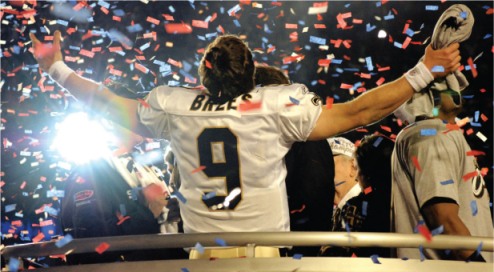February 2010 has a lot to offer both sports fans andspecial-event insurers, featuring the year's biggest Americansporting spectacle–the NFL's Super Bowl XLIV–followed by a seriesof athletic contests watched by hundreds of millions during theWinter Olympics, which started this past weekend in Vancouver,Canada.
|For insurers, mega-events such as a Super Bowl, Olympics, WorldCup–or even large but local events like outdoor musicfestivals–feature a wide range of risks and offer a littlesomething for everyone who wants a piece of the coverage pie.
| As for the types of insuranceinvolved in covering events of such a large scale, Lori Shaw,sports and leisure practice leader for Aon Entertainment PracticeGroup, said the main one will be general liability. Primarycarriers will write this coverage, she said, with umbrella carriersfilling out the excess capacity for additional coverage such asliquor liability.
As for the types of insuranceinvolved in covering events of such a large scale, Lori Shaw,sports and leisure practice leader for Aon Entertainment PracticeGroup, said the main one will be general liability. Primarycarriers will write this coverage, she said, with umbrella carriersfilling out the excess capacity for additional coverage such asliquor liability.
Offsite events, if part of the organizer's scheduled main event,may also be covered, Ms. Shaw said, adding that other coverage suchas media liability may come into play, which would offer insuranceshould an unplanned occurrence end up on television.
|Because mega-events are so highly publicized, Ms. Shaw said,with tens of millions of people tuning in at any given time, a lotcan happen on camera beyond the control of those responsible forthe event.
|Event cancellation coverage–costs, expenses and loss of profitshould the event be cancelled–is also a big coverage for theseevents, according to Robert Barron, a broker in the Accident,Health, Sports and Contingencies team at Lockton International'sLondon office.
|Those connected with the event will also require coverage, Mr.Barron noted–citing caterers as one example.
|Some events also feature spin-offs that offer opportunities forcertain insurers, Mr. Barron said. For example, he noted that forthe World Cup, players' contracts may have bonuses associated withthe event–paying the player extra money should that player's teamwin.
|Mr. Barron said there is a fair-sized market in London forcovering these bonuses, particularly for sports such as golf,tennis, motor sports and soccer. Sports such as baseball andfootball, he said, generally stay in the U.S. market.
|Other types of spin-offs would be, in the Olympics for example,coverage for a superstar who may carry the torch as part of theOpening Ceremonies, Mr. Barron said. For the Super Bowl, coveragewill almost certainly be secured for halftime performances, headded.
|Phillip Eaglestone, a partner in the Health & Specialtydivision of Glencairn Ltd.–which is a unit in Willis' third-partywholesale brokerage business, Faber & Dumas–prepared a list ofmost coverages venue organizers should consider (seeaccompanying sidebar).
|“Crucially, there is a common theme across all events in thatthe main insurance requirement is for contingent financial riskprotection, which provides support to the organizer in its effortsto achieve successful fulfillment of the event, and which enablesthe organizer to meet its obligations and responsibilities tobroadcasters, sponsors and the public alike,” he said.
|Contingency insurance, Mr. Eaglestone added, provides financialindemnity for both physical and non-physical losses that can arisefrom the risks he listed.
|Of course, the threat of terrorism is also a concern at anymega-event, and insurers offer coverage for that as well.
|“The events of Sept. 11, 2001 changed the world forever” formega-event insurers, according to Mr. Eaglestone. “Global awarenessof the risk of terrorism increased many fold, and in many respectslarge sporting events represent an ideal target for terrorists. Notonly do these events attract large crowds concentrated withinconfined spaces, the events are attended by heads of state,dignitaries and high profile celebrities.”
|Meanwhile, he added, “coupled with the fact that these eventsare watched by hundreds of millions of viewers via globaltelevision broadcasts, [attacking mega-events] represents an idealopportunity for maximum impact. The fastest-growing proportion ofany organizer's costs relates directly to providing adequatesecurity for the event.”
|He said although the industry suffered as a result of Sept. 11,leading to increased rates and decreased capacity in the immediateaftermath, the market has rebounded and has seen the emergence ofnew capacity and pressure on rates.
|For mega-events, Ms. Shaw said carriers will usually includeterrorism coverage. Very large events, she noted, get securityreinforcements from the government.
|Speaking to who is writing the coverages, Mr. Barron said justabout the whole London market will be involved for a mega-event. Hesaid there is a niche for special events in London, but for eventsof the scale of a Super Bowl, Olympics or World Cup, the widermarket gets involved. Standard carriers will even take on somecoverages, he said, if the risk is that big.
|Ms. Shaw agreed. “You'll see a variety of different insurerscomplement each other on [the risk],” she said, adding that thecoverages and limits involved usually require bringing in vastresources.
|The organizer seeking coverage, she noted, will go to onebroker, who will in turn secure the necessary coverages fromcarriers. But even there, she said, multiple purchasers may beinvolved within the same event, meaning multiple brokers may alsobe involved.
|Mr. Eaglestone said there is a healthy and competitive marketfor large sporting risks, but mega-events require a specialapproach, with less room for competition on price. The events use amix of insurers and reinsurers, as well as financial marketproducts such as catastrophe bonds, to generate the levels ofcoverage required, he noted.
|“It is for these events where capacity is derived on a globalbasis, and therefore by necessity rating can be less flexible inorder to entice those insurers who do not usually underwrite eventbusiness to do so,” Mr. Eaglestone explained.
|The multitude of coverages involved means a lot of premiumdollars as well, market experts told NationalUnderwriter.
|“It is not uncommon these days for a major sporting event togenerate many hundreds of millions of dollars in revenues, withevents such as the Olympics having been described as the equivalentof starting a Fortune 500 company and dismantling it shortlythereafter,” according to Mr. Eaglestone.
|He said high premiums are necessary to cover events with bigoperational fixed costs, producing revenues that can exceed $1.5billion.
|An event like the World Cup can generate around ?500 million(about $793 million, under current exchange rates), according toMr. Barron. He said there is always some fighting over price andwhich carrier leads, but he explained that “with something thatbig, everyone knows they'll see something.”
|Smaller risks generating ?10-to-?20 million pounds ($16-to-$32million), Mr. Barron noted, will see more fierce competition.
|However, Ms. Shaw said carriers could get competitive overmarquis events, as carriers want to be associated with them.
|As a broker, she said it is important to determine whether thecarriers understand the type of event they are trying to insure,and whether the carrier is set up to handling potential claims.
|Although individual risks and coverages have their ownintricacies, Mr. Eaglestone cited several general areasunderwriters will consider when evaluating a mega-event (seeaccompanying sidebar).
|Still, according to Mr. Barron, the principles involved inunderwriting a mega-event are not all that different fromsmaller-scale events.
|“At the end of the day, an event's an event,” he said.Underwriters will determine if the venue can support the size ofthe events, if the venue can handle weather events such as amassive amount of rain in a short time, etc.
|He added that each risk is different. A Super Bowl held in alarge stadium will be well-suited to handle 100,000 people, henoted, while an outdoor music festival, such as Glastonbury, isdifferent, as underwriters must consider the logistics of having150,000 people in a field.
|Ms. Shaw said underwriters will look at the historicalprevalence of occurrences at similar large events, and alsoconsider the venue's age and possible security issues.
|Ultimately, for the insurance industry, mega-events presentopportunities for sizable premiums spread among many companies.Industry members also achieve a certain level of prestige beingassociated with such events.
|But the risks are present as well. As Ms. Shaw noted, withevents of this size, “you never know what's going to happen thatmight give rise to a claim.”
Want to continue reading?
Become a Free PropertyCasualty360 Digital Reader
Your access to unlimited PropertyCasualty360 content isn’t changing.
Once you are an ALM digital member, you’ll receive:
- All PropertyCasualty360.com news coverage, best practices, and in-depth analysis.
- Educational webcasts, resources from industry leaders, and informative newsletters.
- Other award-winning websites including BenefitsPRO.com and ThinkAdvisor.com.
Already have an account? Sign In
© 2024 ALM Global, LLC, All Rights Reserved. Request academic re-use from www.copyright.com. All other uses, submit a request to [email protected]. For more information visit Asset & Logo Licensing.








